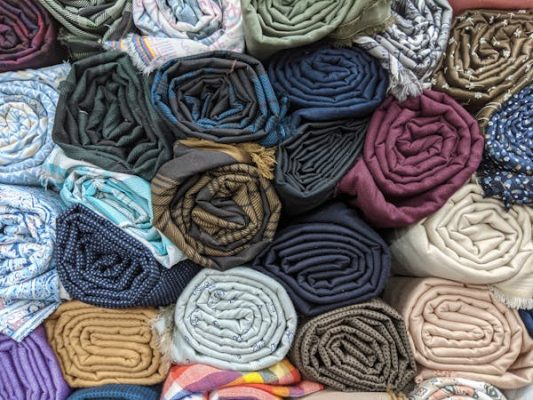We live in a world surrounded by fabrics. Textiles play a vital role in our lives, from the clothes we wear to the furniture we sit on. A large portion of these fabrics are synthetic. Synthetic fabrics are human-made materials. They offer a range of benefits, but they also come with environmental concerns. This post will explore the pros and cons of common synthetic fabrics. We will delve into their impact on our planet and discuss how to make more informed choices.
What are Synthetic Fabrics?
Synthetic fabrics are made from synthetic polymers. These polymers are derived from petroleum. This is a non-renewable resource. Common examples include polyester, nylon, acrylic, and spandex. These materials are created through chemical processes. Unlike natural fibers like cotton or wool, they don’t grow in nature.
The Alluring Advantages of Synthetics
Synthetic fabrics have several attractive qualities. These qualities contribute to their widespread use.
-
Durability: Synthetic fibers are incredibly strong. They resist tearing, stretching, and shrinking. This makes them ideal for items that need to withstand wear and tear. Think of sportswear or outdoor gear.
-
Water Resistance: Many synthetics repel water. This makes them perfect for raincoats, umbrellas, and swimwear. Some synthetics also wick moisture away from the skin. This keeps you dry and comfortable during exercise.
-
Wrinkle Resistance: Synthetic fabrics are often wrinkle-resistant. This makes them convenient for travel and everyday wear. They require less ironing than natural fabrics.
-
Affordability: Synthetics are typically cheaper to produce than natural fibers. This makes them accessible to a wider range of consumers. This lower cost can be tempting for budget-conscious shoppers.
-
Versatility: Synthetic fabrics can be engineered to have specific properties. They can mimic the feel of silk, wool, or cotton. This allows for a wide range of textures and appearances.
The Environmental Impact: The Other Side of the Coin
While synthetic fabrics offer many advantages, their production and disposal have significant environmental consequences.
-
Reliance on Fossil Fuels: Synthetic fabrics are derived from petroleum. This is a fossil fuel. Its extraction and processing contribute to greenhouse gas emissions. These emissions contribute to climate change.
-
Microplastic Pollution: Synthetic fabrics shed tiny plastic particles called microplastics when washed. These microplastics enter waterways. They contaminate oceans and harm marine life. They can even enter the food chain.
-
Non-Biodegradability: Most synthetic fabrics don’t break down easily in the environment. They can persist for hundreds of years in landfills. This contributes to the growing problem of textile waste.
-
Water Usage: While the fabrics themselves may be water-resistant, their production can require significant amounts of water. This can strain water resources in certain regions.
-
Chemical Use: The production of synthetic fabrics often involves harsh chemicals. These chemicals can pollute water and air. They can also pose risks to workers’ health.
A Closer Look at Common Synthetic Fabrics:

Let’s examine some specific synthetic fabrics in more detail:
-
Polyester: Polyester is widely used in clothing, upholstery, and bedding. It’s durable, wrinkle-resistant, and affordable. However, it’s not very breathable.
-
Nylon: Nylon is known for its strength and elasticity. It’s used in everything from stockings to parachutes. It’s also resistant to abrasion and mildew.
-
Acrylic: Acrylic is often used as a wool substitute. It’s soft, warm, and lightweight. However, it can be prone to pilling.
-
Spandex (Lycra/Elastane): Spandex is highly elastic. It’s added to other fabrics to provide stretch. It’s commonly found in sportswear and swimwear.
Making Sustainable Choices: Navigating the World of Synthetics

As consumers, we can make more sustainable choices regarding synthetic fabrics.
-
Choose Recycled Synthetics: Look for clothing made from recycled polyester or nylon. This helps reduce the demand for virgin plastic.
-
Prioritize Quality over Quantity: Invest in durable, high-quality synthetic garments. This will help them last longer, reducing the need to replace them frequently.
-
Wash Clothes Less Often: Washing clothes less frequently reduces microplastic shedding. Airing out clothes between wears can often suffice.
-
Use a Guppyfriend Washing Bag: These bags help capture microplastics released during washing, preventing them from entering waterways.
-
Support Sustainable Brands: Choose brands committed to ethical and sustainable practices in their production processes.
-
Explore Natural Fiber Alternatives: Consider opting for natural fibers like cotton, linen, or wool whenever possible.
Conclusion: Finding a Balance
Synthetic fabrics have become an integral part of our lives. They offer undeniable benefits in terms of durability, affordability, and versatility. However, their environmental impact is a serious concern. By understanding the pros and cons of these materials, and by making informed choices, we can strive to minimize our environmental footprint. We can embrace a more sustainable approach to fashion and textiles. The future of our planet depends on it. We must find a balance between the convenience of synthetics and the health of our environment. This requires conscious consumption and a commitment to sustainable practices. By working together, we can create a more sustainable future for the textile industry.
About IGREEN TEX
IGREEN TEX is a provider of fashion and textile products, offering a wide range of apparel both domestically and internationally. Our commitment to quality ensures that our products not only meet the highest standards but also promote eco-friendly practices.
IGREEN TEX VIETNAM CO LTD
Address: No. 83, A4 Street, Ward 12, Tan Binh Dist, HCMC
Tax code: 0315844409
Email: info@igreentex.com
WhatsApp/Viber/Zalo: +84 938.045.900


